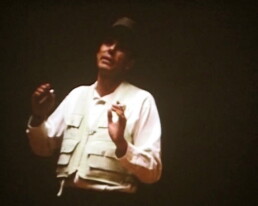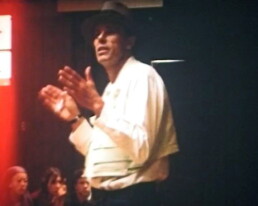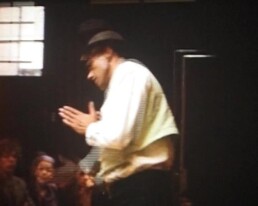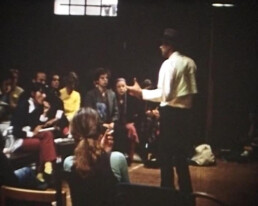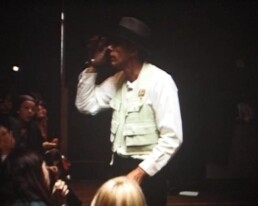ZORAN POPOVIĆ (1944)
Gestural Speech of Joseph Beuys
8mm film, regular, colour, 18fps digitally remastered
15’ 55”
edition 2/5 (5+2AP)
1973/2016
Gestural Speech of Joseph Beuys
8mm film, regular, colour, 18fps digitally remastered
15’ 55”
edition 2/5 (5+2AP)
1973/2016
The film was edited in 1973, when it was also shown in Student Cultural Centre; it was shown several more times during the 1970s, after which the author forgets about the film, the ways of art leading him elsewhere.
However, editor at the “Menjačnica (Exchange Office)” Gallery of the Goethe Institute started a programme of exhibitions in 2016 (which has continuously been going on to date, for full five years), with the idea of presenting the work of the artists who in any way collaborated with German artists or created work that in any way interacts with German arts and culture. I remembered then that I had at a certain point recorded a not inconsiderable series of black-and-white photos and colour slides, as well as the mentioned film. For this occasion, I accepted the job and digitally postproduced this film. I re-edited it, added several frame sequences, and recorded instrumentals for musical background, which was Richard Wagner’s. This digital version of the film was made in 2016 from the material recorded in 1973.
The premiere of the digital version of the film was in the Goethe Institute on 3 March 2016, as part of the exhibition Document as a Work of Art: Gestural Speech of Joseph Beuys, Film and Photography by Zoran Popović, 1973 (Edinburgh Art Festival). “Menjačnica” Gallery of the Goethe Institute in Belgrade.
Zoran Popović, artist
In the “Menjačnica” Gallery of the Goethe Institute, the artist exclusively presented the film and photographs made in 1973, when he recorded the twelve-hour lecture of the world-renowned German artist Joseph Beuys at Edinburgh Art Festival, where he himself had an exhibition. At Edinburgh Art Festival in 1973, in the Eight Yugoslav Artists exhibition organised in the Richard Demarco Gallery, Popović presented his graphics and slide projections of his two performances, previously put on in Belgrade (the Axioms performance, put on in the Student Cultural Centre gallery in September 1972, and the photo performance Hiding behind Sally Holman, made in Tašmajdan park in June 1973).
At the mentioned festival, as part of the Richard Demarco Gallery’s programme, which was presented on 19 August 1973 in the Melville College theatre, Marina Abramović, Gergelj Urkom, Raša Todosijević, and Zoran Popović each presented their performances on the same stage at the same time.
In the same location, on 20 August 1973, Popović used an 18mm camera to record Joseph Beuys’s performance: Twelve Hour Lecture: A Homage to Anacharsis Cloots (Anachrasis Cloots, Prussian nobleman, born in the vicinity of the German town Kleve, was an important figure in the French Revolution and a member of the French Parliament from 1792 to 1794). Popović’s fifteen-minute film focuses on the bodily and gestural speech of Joseph Beuys. Popović complemented the film with music, which additionally emphasises the aesthetic and reduces the pragmatic interest in Beuys’s action, and also establishes the difference between fomal transfer of contents and bodily shape of communication. Beuys’s lecture and Popović’s film are two extremes that operate effectively as a whole.
Apart from this film, the Goethe Institute Gallery also exhibited some 30 photos, colour and black-and-white, of smaller and larger formats, whose content corresponds to the film, while the photos are additionally interesting as a document because the faces in the audience are those of the Belgrade art scene of the time: Biljana Tomić’s, Raša Todosijević’s, Gera Urkom’s, Neša Paripović’s, Marina Abramović’s, Jasna Tijardović’s, Nuša’s and Srečo Dragan’s, Irina Subotić’s, Žika’s and Sanja Gligorijević’s, Tom Marioni’s (an artist, writer, and curator who founded the Museum of Conceptual Art in San Francisco in 1970).
In addition to the obvious documentary quality, this work dedicated to Beuys also has a way of pointing out different affinities of Popović’s narratives, from the biographical to the analytical and theoretical ones, and indirectly relating the times, manners, influences, and exchanges within the art practice of the period.
Una Popović
© Cultural Centre of Belgrade, the October Salon Collection and the artist
Purchase agreement: III-5-300/22.10.2021.
Inventory No. 1708
Photo: video frame, courtesy of the artist
ABOUT THE AUTHOR:
Zoran Popović (1944, Belgrade, Serbia) has been present on the Serbian and former Yugoslav scene for more than forty years, and his role has also been rather prominent in relevant international art events (to which the artist’s detailed biography and bibliography testify). The following general information from his rich artistic biography should particularly be emphasised. He was a member of the historic group of six artists who in the early 1970s brought the ideas and actions of the so-called new art practice to Belgrade, effecting one of the greatest transformations in understanding the language of art and the means of artistic expression. In this context, Popović is the author of a series of seminal pioneer works, such as the first artist film – the 1968 Head/Circle, as well as a whole system of drawings, photographs, posters, installations, and performances, titled Axioms (1971-1973).
During his stay in New York, in 1974 he made personal and professional contact with core representatives of the American conceptual art; he took part in the happenings they organised and collaborated with The Fox journal (1975). His stay in New York is documented by the socially-engaged auteur film Struggle in New York (1976), which is an anthological piece of conceptual art in Serbia and worldwide. He participated in numerous presentations of contemporary Yugoslav art abroad (Edinburgh, Vienna, Warsaw, Modena, Dortmund, Berlin, Brussels, Luxembourg, Rome, Genoa, etc.) as well as in the 1977 Paris Youth Biennale. His work was featured in the retrospective exhibition New Art in Serbia from 1970 to 1980, organised by the Museum of Contemporary Art in 1983, the same year in which he also staged a solo exhibition titled New Iconoduly in the Salon of the Museum of Contemporary Art, which opened a new stage and initiated a whole series of ideas and achievements that has to date been growing and developing. He deals with theoretical work and exhibition organisation; he is active in the cultural and artistic life of his community. He took part in the highly significant international exhibition in Bonn in 1994, during which the suggestion was made that, after the fall of the Berlin Wall, East-European and West-European art scenes should be merged (Europa – Europa Das Jahrhunderet Der Avantgarde In Mitel und OstEuropa/Europe – Europe, One Hundred Years of Avant-Garde in Central and Eastern Europe), and his work was also featured in René Block’s 2003 exhibition In den Schluchten des Balkan, in the Fridericianum in Kassel. His contributions and papers dealing with his work can be found in numerous publications in the country and abroad, among which the most significant include Theories and Documents of Contemporary Art (Berkeley: University of California Press, 1996) and Art and Social Change: A Critical Reader – Anthology (Tate Publishing with Afterall, London, 2007), which contain his text “For Self-Management Art.” The second edition of this book, published in Portuguese and English in Sao Paolo, was intended for Brasil and Latin America. He is the winner of several coveted awards, including the “Sedam sekretara SKOJ-a” (“Seven Secretaries of the Union of Communist Youth of Yugoslavia”), which was of great importance in the Yugoslav context (Zagreb, 1973); 31st October Salon award for drawing (Belgrade, 1990); the Branko Vučićević Award (Belgrade, 2019). He is a member of the Association of Fine Artists of Serbia.
(The author’s narrative biography written by Jerko Ješa Denegri)
